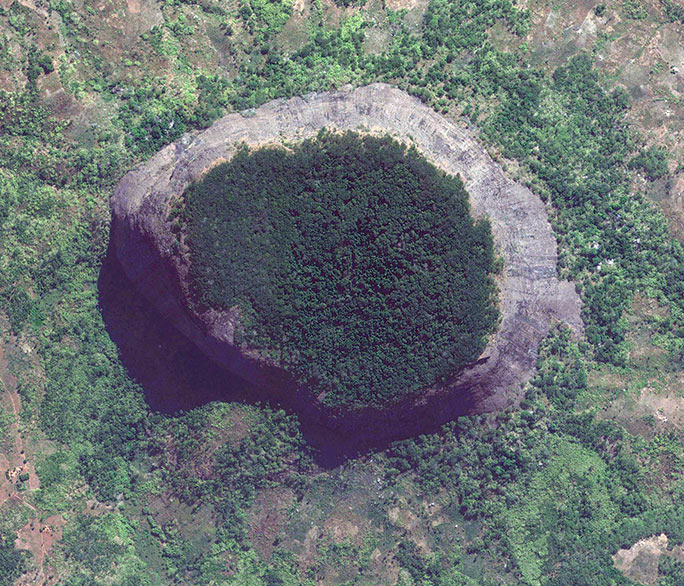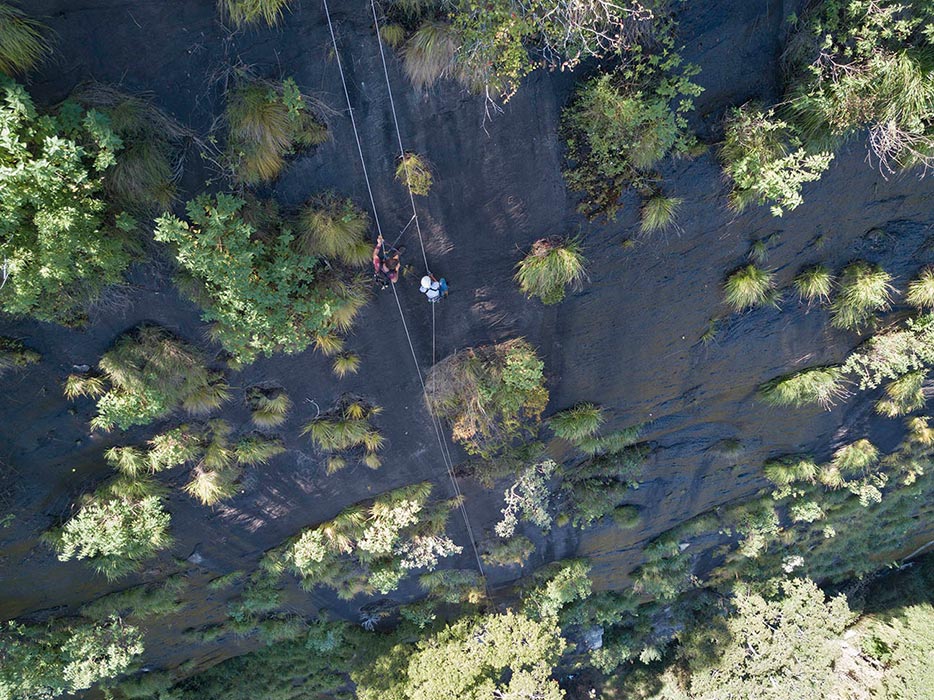It’s not every day that a professor calls you up and asks if you can set-up some ropes on an ‘unclimbed’ mountain in Mozambique. I think such things should be embraced immediately. Actually, the first call came from Jules Lines, granite soloist and all-round cool guy. He’d been conversing with the Prof for some time; it had been top secret, but now, in view of the Prof’s various bids for sponsorship, the cat was out of the bag.
The goal was Monte Lico, a fine lump of granite standing proud somewhere in northern Mozambique. Imagine dropping Yosemite’s half dome into the equatorial jungle, slicing the top off it, and adorning it with a whopping great jungle. That’s the gist of it. The Prof, otherwise known as Julian Bayliss, had been researching this feature for over five years; he was keen to find new species up there, and he wasn’t about to give up.
In February last year, Julian made a reconnaissance of the site and the local people said they know of no one, living or past, who had been to the forest on top of Mount Lico. They did mention that during the colonial period a group of Portuguese soldiers tried to climb the mountain but the rope snapped in a fall and they all died.
Enter Jules and myself. Our mission, should we choose to accept it, was to free climb the granite face, and set up some static ropes for the various scientists that were hoping to go up. Yeah, we’d studied drone footage, we’d seen it on Google Earth, but it was one of those big unknowns, of course. Protection? The true height? How much kit to take along with us? And would our ‘uninitiated’ scientists actually have the cajones to make the arduous trip up the ropes?




Our first leg took us via Johannesburg to Malawi, where we landed at Blantyre. It was here that we did the monumental pack of the four 4x4s. The next leg took us down to the international border, where our ever-growing team filled out forms and crept inexorably into the beautiful country of Mozambique. This country is Portuguese-speaking (the Portuguese began colonisation way back in 1498), and has a rich and turbulent past. Achieving independence in 1975, it then suffered an horrific 15-year civil war, leaving it battered and in a state of collapse. Today things are rather better, with the economy getting stronger. But it remains one of the world’s poorest and most troubled nations.
We arrived at Monte Lico late morning, and our base camp was decided. Whilst the kitchen and campground underwent construction, we nabbed a strong-looking local fellow, and the three of us set about thrashing out a fresh trail to the lowest section of the cliff.
So we sweated, machete’d and wove our way across a valley, through a shallow swamp, and, quite blindly, up a very steep hillside. After four hours (and by some uncanny miracle) we actually arrived at the precise point we’d hoped for. This was celebrated with a taste of the waterfall that poured down Lico’s green and black face. Delicious.


We retraced our new path back to our base camp, which was coming together well. A few scientists had begun straggling in. A few days later, there would be more than 20 of us at base camp. We also received the news that no climbing on Lico would be permitted until the local chiefs had all got together and organised a ceremony. The ceremony would involve flour.
On day two the chiefs arrive. Coffee, tea, fig rolls, digestives. They’re eating all our supplies I thought to myself. An 8ft cobra pops by. Then a chameleon, and a fine-looking mole rat. The locals start bringing fruit, vegetables, even chickens. The chiefs are in no hurry. The flour arrives. This is a signal.
A medium-sized team of locals and carriers set off on our new trail, and Jules and myself follow. The ceremony is carried out, the flour is set out near the cliff in a pleasant little pyramidal display, and some very melodic words are sung, the words drifting away on the breeze… It’s so chilled now, I can barely be bothered to put my harness on. Dozing… Then word goes out, we’ve been officially blessed, and we can proceed. We both fall over each other as we grab ropes, cams, wires. Blimey. This is it – After five years of Bayliss planning – THIS IS IT.


The opening pitch, about 5a, went to Jules. Mostly unprotected, but luckily there was a few cam placements. I took the second pitch, a veering little jungle bash, involving tied-off cabbagey things, and a dry root belay.
Lines got pitch three; a green-ish slab involving another cabbage, some small lizards, and a pretty black and red starling. That pitch sort of stopped dead at a grassy ledge, so I got pitch four, which, at about 5b, was possibly the crux, although this sort of territory all felt pretty similar in grade. I actually found a reasonable belay, and took in the incredible view – which, due to the quite formidable jungle presence, wasn’t always a given. It was down to the jungle skills of Jules to bash out the final 45 metres to a substantial tree at the end of the true climbing. What a legend.
We came, we saw, and we topped out. It was a great moment, and we radioed Julian Bayliss at base camp to tell him the news. He got so excited he almost bought a suit. We then hauled the first of our monster low-stretch ropes up the cliff, from a haul bag at the base. It only remained for us to abseil off and go and drink cold (read: warm) beer, and have everyone pat us on the backs and tell us how intrepid and daring we both were. Oh, shucks, folks. ’twas nothing. Really.
The next two weeks mostly featured the two of us ferrying big loads and food up the face (no hauling could be achieved here), and teaching the scientists, who are a thoroughly gritty and resourceful bunch, to jumar 125m up our two fixed 10.5mm Worksafe Plus ropes. The really astonishing thing is that everyone who wanted to, did it. It was quite incredible, and we took our hats off to the sort of people that, at any age from thirty to sixty-four, find the strength to learn to jumar a 125m rope in a jungle, with no previous experience. It was truly astonishing.
Editor’s footnote: The first email I got from Mike on his return, read: “Slight delay with the words… on account of the fact that I'm in a specialist hospital in London with Malaria. But the prognosis is good. Chat very soon… Mikey”
The expedition was funded by the TransGlobe Expedition Trust, Biocensus, The African Butterfly Research Institute, DMM Climbing, and Marmot tents.





